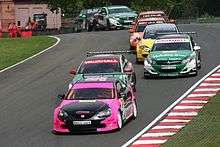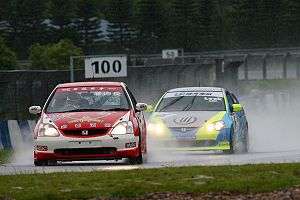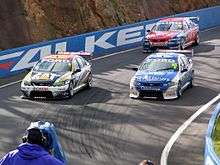Touring car racing
Touring car racing is an auto racing competition with heavily modified road-going cars. It is popular in Argentina, Australia, Brazil, Britain, Germany, Sweden and Norway.
While not nearly as fast as Formula One, the similarity of the cars both to each other and to fans' own vehicles makes for entertaining, well-supported racing. The comparatively lesser effect of aerodynamics also means that following cars have a much easier time of passing than in F1, and the more substantial bodies of the cars makes the occasional nudging for overtaking much more acceptable as part of racing.
As well as short "sprint" races, many touring car series include one or more endurance races, which last anything from 3 to 24 hours and are a test of reliability and pit crews as much as car, driver speed and consistency.
Characteristics of a touring car

While rules vary from country to country, most series require that the competitors start with a standard body shell, but virtually every other component may be allowed to be heavily modified for racing, including engines, suspension, brakes, wheels and tyres. Aerodynamic aids are sometimes added to the front and rear of the cars. Regulations are usually designed to limit costs by banning some of the more exotic technologies available (for instance, many series insist on a "control tyre" that all competitors must use) and keep the racing close (sometimes by ballast weight where winning a race requires the winner's car to be heavier for subsequent races).
In this, it shares some similarity with the American stock car racing (governed by NASCAR). However, touring cars are, at least notionally, derived from production cars while today's NASCAR vehicles are based on a shared, custom, design.[1] In the early days of NASCAR, stock cars were in fact built from production cars, whereas some current touring car series are also raced in silhouette racing cars. Touring cars race exclusively on road courses and street circuits, while its American counterpart predominantly utilises oval tracks, with road courses constituting a small percentage.
Differences between touring cars and sports cars
For the casual observer, there can be a great deal of confusion when it comes to classifying closed-wheel racing cars as 'touring cars' or 'sports cars' (also known as GT cars). In truth, there is often very little technical difference between the two classifications, and nomenclature is often a matter of tradition.
Touring cars are usually based upon family cars (such as hatchbacks, sedans or estates), while GT racing cars are based upon more powerful and expensive sports cars, such as Ferraris or Lamborghinis (and are thus usually coupes). Underneath the bodywork, a touring car is often more closely related to its road-going origins, using many original components and mountings, while some top-flight GT cars are purpose-built tube-frame racing chassis underneath a cosmetic body shell. More recently, there has been an increasing push to make GT cars closer to the road cars with the GT3 set of regulations. Many touring car series, such as the BTCC and the now-defunct JTCC distinguish themselves from sports car racing by featuring front-wheel drive, four-wheel drive and rear-wheel drive cars with smaller engines. Most sports car championships only allow rear-wheel drive cars.
While touring cars generally have a lower technical level than sports cars, there are some exceptions. The Deutsche Tourenwagen Masters (DTM) is considered to be one of the most technologically advanced racing series in the world, with cars that, underneath their body shells, are more purebred racing machines than most FIA-GT vehicles.
When Sports car racing was created in the inter-war period of the 20th century however, sports cars fulfilled the role Touring Cars do today, as the production car variant of racing compared to the specialised vehicles competing in Grand Prix racing. Over time Touring Cars has drifted from its role as racing cars based on modern road cars with categories like NASCAR and DTM having little to no connection to road cars. This in turn has led to the rise of Production car racing to fulfil the role once performed by Touring Cars and Sports Cars before that.
Series of competition
World Touring Car Championship
_opening_lap.jpg)
Worldwide
Modern World Touring Car Championship (WTCC) started in 2005, evolving from the reborn European Touring Car Championship.
Running at major international racing facilities, this series is supported by BMW, SEAT and Chevrolet. The latter fields a works team, whereas the other two only sell racing kits to be installed on their cars, providing technical support to their customers. In 2011 Volvo also entered the championship, fielding a one-car team as an evaluation for a possible heavier commitment to the series. The World Touring Car Championship features 1.6-litre cars built to Super 2000 regulations based on FIA Group N.
Following the trend of recent FIA rules, cost control is a major theme in the technical regulation. In 2011 the rules concerning the engine capacity have changed, switching from 2000 cc to 1600 cc turbo engines. Cars equipped with the old 2000 cc engines are still eligible in the championship. Many technologies that have featured in production cars are not allowed, for example: variable valve timing, variable intake geometry, ABS brakes and traction control.
British Touring Car Championship

United Kingdom
The British Touring Car Championship (BTCC) currently competes at nine circuits in the UK with cars built either to Next Generation Touring Car or Super 2000 specification, with ballast being used to equalise the two types. From 2011, cars that ran to the BTCC's own Next Generation Touring Car specification were eligible to compete in a phased move away from Super 2000 regulations. Cars are 2.0-litre saloons and hatchbacks with around 270 bhp (200 kW) and can be front or rear-wheel drive. During the 2012 season works teams entries come from MG and Honda. Since BTCC budgets have been kept relatively low, there is a strong independent and privateer presence in the championship. Manufacturers represented by privateers include BMW, Vauxhall, Ford, Toyota, Volkswagen and Audi.
Prior to 2001 the BTCC was contested by cars built to 2.0-litre supertouring regulations and had in its heyday up to nine different manufacturers. Joachim Winkelhock stated on several occasions that it was the best touring car championship in the world, and many champions of that era now race in the World Touring Car Championship (WTCC). Between 2002 and 2006 the BTCC ran its own Touring class with Super Production/Super 2000 cars making up the numbers; the Touring class was phased out (only privateers are eligible to run old Touring cars) with the intention of a pure Super 2000 series. The introduction of the Next Generation Touring Car specification, from 2011, started a phased transition from Super 2000 cars in an effort to cut costs and improve the sport.
DTM

Germany/Europe
The DTM series, the initials standing for Deutsche Tourenwagen Meisterschaft until 1996, then following a hiatus, revived as Deutsche Tourenwagen Masters in 2000, features advanced purpose built V8-powered space frame machines, covered with largely carbon fibre bodyshapes resemblant of the manufacturers' road machine (although the roof and roof pillars do originate from the production car).[2] In order to lower costs, the engine power is limited to 600 hp (450 kW) , and transmissions, brakes and tyres (Dunlop) are standard parts for all. Also, dimension and aerodynamics are equalised. The approx. 1,050 kg (2,310 lb) light DTM cars corner incredibly quickly and wear spectacular bodykits incorporating huge wheel arches and diffusers.
More than 20 works-backed entries of Opel Astra, Audi TT and Mercedes-Benz CLK contested the revived 2000 DTM series but a serious issue developed for the series when Opel pulled out ahead of the 2006 season. The series has survived this hurdle and remained popular with 18 Audi A4 and Mercedes-Benz C-Class contesting the present series.
For the 2012 season, the regulations have been adapted to make the vehicles less reliant on aerodynamic downforce and more on mechanical grip. Audi will switch from their A4 model and use the A5, Mercedes will use the Coupe version of their C-Class and BMW have announced their addition to the competition with their M3 Coupe.
Nürburgring VLN Endurance racing Series
Germany
Since 1997, and nowadays still on the over 20 kilometres (12 mi) long famous old Nürburgring and other circuit worldwide, in average over 150 touring cars compete in the VLN series of ten typically 4 hour long races. Cars range from old 100 hp (75 kW) road legal compacts to 500 hp (370 kW) Porsche 996 and even modified DTM cars (1,250 kg (2,760 lb)). Most entrants of the 24 Hours Nürburgring collect experience here.
Scandinavian Touring Car Championship

Sweden/Denmark
Between 1996 and 2010 the Swedish Touring Car Championship contained various races in Sweden and a few in Norway. The most successful car makes were Volvo, BMW, Audi and Nissan. In 2010 the championship merged with the Danish Touringcar Championship to form the Scandinavian Touring Car Championship. The 2010 champion was Robert Dahlgren, because he had achieved the best results from selected races in the Danish and Swedish championships. Rickard Rydell and Johan Kristoffersson won the championship in 2011 and 2012, in a Chevrolet and a VW, respectively. In 2013 the series merged with the TTA – Racing Elite League to form the 2013 STCC – Racing Elite League season, starring 17 drivers for Volvo, BMW, Saab, Citroën, Dacia and Honda.
V8 Supercars

Australia and New Zealand
Formerly the Australian Touring Car Championship, the current formula was devised in 1993 (based on Group A regulations) and branded as 'V8 Supercars' in 1997. The series features grids of twenty-eight cars (although in endurance races e.g. the Bathurst 1000 there can be wildcard entries, which add to the grid) with 650+ hp (480 kW). The cars are Ford Falcons, Holden Commodores and other medium/large sedan makes. The weight limit for a V8 Supercar is 1,350 kg (2,980 lb). The race cars themselves are derived from production body panels and space frame chassis. Both Holden and Ford financially and technically support their favoured teams and take an active role in promotion of the series.
As the series has grown, major international motorsport organisations have become involved. Several teams now benefit from the involvement of Tom Walkinshaw Racing and Triple Eight Race Engineering. In addition to regular appearances in New Zealand (currently using the Pukekohe Park Raceway), the series ventured to China at the Shanghai International Circuit in 2005, since 2006 has raced at the Bahrain International Circuit and since 2010 has raced at the Yas Marina Circuit in Abu Dhabi. In 2013, the series added a race in the U.S. at the Circuit of the Americas near Austin, Texas. The growth of the series has seen motorsport equal Rugby League as Australia's third most watched sport.
From 2013, Nissan [3] provided a third manufacturer, working with Kelly Racing. Mercedes-Benz also joined the series in 2013 with Stone Brothers Racing, in conjunction with Erebus Racing.[4][5] Volvo also joined the championship in 2014 with Garry Rogers Motorsport, in conjunction with Polestar Racing.
The series incorporates the world famous Bathurst 1000 race as a championship round. Because of the longer distance, regulations require two drivers per car for this race. This also applies to the Sandown 500 & the Gold Coast 600. These events make up V8 Supercars 'PIRTEK Enduro Cup', which is a championship-within-a-championship where the driver combination with most points collected over the 3 Enduros wins a trophy.
Other series
Americas
- TC 2000 Championship (Argentina) (1979-still)
- SCCA Pro Racing World Challenge- during the SpeedVision/Speed Channel era, the "touring cars" in this series were lower performance vehicles modified to almost the same extent as the American Le Mans Series and Rolex Sports Car Series caliber grand touring cars. After the touring cars became a BMW-Mazda-Acura affair, the series was reformatted to include a new touring car class mostly sharing Grand Am's Continental Tire Sports Car Challenge vehicles. Shortly later, a lesser "B-Spec" group was added.
- Canadian Touring Car Championship
- CDCC Dominican National Championship
- U.S. Touring Car Championship (link)
- Continental Tire Sports Car Challenge- features both a sports car based "gran sport" class and a touring car based "street tuner" class.

- Stock Car Brasil (1979-still, link)
- American Touring Car Championship link (2009-still)
- Copa Petrobras de Marcas (link)
Europe
- ADAC Procar Series (Germany), formerly DMSB-Produktionswagen-Meisterschaft (DPM) with ETCC rules (1995-still)
- Renault Eurocup Mégane Trophy
- European Touring Car Cup, held at various European circuits since 2005
- Baltic Touring Car Championship
- Finnish Touring Car Championship (1987-still)
- Irish Touring Car Championship
- Portuguese Touring Car Championship
- Russian Touring Car Championship
- Cruze Cup (One-make series)
Asia-Pacific
- Australian V8 Touring Car National Series, link

- Hong Kong Touring Car Championship (2002-still)
- Asian Touring Car Championship (2000–2002, 2005-still)
- Philippine Touring Car Championship (formerly the PNTCC)
- China Touring Car Championship
- Malaysian Super Series
- Macau Touring Car Championship (? - still)
- NZ Touring Cars
- V8 Supercars Development Series
- Saturday Night Fever Challenge Series - Malaysia (Club Event Series)
Former series
- The old World Touring Car Championship, plagued by lack of support from the FIA, raced under the Group A regulations in 1987.
- Germany's former DTC adopted ETCC rules in 2004 and was renamed to DMSB-Produktionswagen-Meisterschaft (DPM) until 2005
- Benelux Racing League 2004-2009
- Belgian Touring Car Series, last season in 2011.
- Australian Super Touring Championship ran from 1993 to 2001.
- Japanese Touring Car Championship (JTCC) ran from 1994 through 1998.
- Super Tourenwagen Cup (STW) ran from 1994 through 1999.
- North American Touring Car Championship (NATCC) ran from 1996 to 1997.

- Swedish Touring Car Championship (1996–2010)
- South American Super Touring Car Championship ran from 1997 through 2000.
- Norwegian Touring Car Championship
- Danish Touring Car Championship (1999–2010)
- Italian Superturismo Championship (1987–1999, 2003–2008)
- Superstars Series (2004-2013)
- French Supertouring Championship (Championnat de France de Supertourisme), last season in 2005.
- Campeonato Español de Turismos (Spanish Touring Car Championship) ran from 1959 to 1998.
- Bankfin Touring Car Championship (South African Touring Car Championship) which ended in 2000.
- Deutsche Tourenwagen Meisterschaft (1984–1994) then turned to ITCC by the FIA in 1995, based in heavily modified cars, began to be too expensive and due to retirement from Opel and Alfa Romeo the ITCC series were cancelled in 1996.
- V8Star Series
- New Zealand V8s (1994-2015)
- V8SuperTourer
Famous races

- Bathurst 1000 held at Mount Panorama Circuit since 1963, part of V8 Supercars Championship (the race was held at Phillip Island from 1960–1962)
- Spa 24 Hours since 1924-1989
- 24 Hours Nürburgring at the famous old Nürburgring, since 1970, related to VLN series there
- Macau Grand Prix Guia Race (contested as part of WTCC since 2005)
- Tourist Trophy held until 1988
- Wellington 500, held at the Wellington street circuit between 1985 to 1996
- InterTEC (インターTEC), held at Fuji Speedway as part of the JTCC round through the series duration until the series' demise in 1998
Rule sets
Different sets of regulations do apply:
- Contemporary touring car racing: Group A · Group F · Group G · Group H · Group N · Group S · Group SE · Group SP · Next Generation Touring Car · Super 2000
- Historic touring car racing: Group 1 · Group 2 · Group 3 · Group 4 · Group 5 · Group B · Supertouring
References
- ↑ "What is the NASCAR Car Of Tomorrow?". Nascar.about.com. 4 April 2008. Retrieved 20 August 2009.
- ↑ Audi UK - http://www.audi.co.uk (6 May 2009). "Audi UK > Experience > Motorsport > DTM > The Audi A4 DTM". Audi.co.uk. Retrieved 20 August 2009.
- ↑
- ↑ "Mercedes-Benz to join V8 Supercars". Herald Sun. Retrieved 19 September 2012.
- ↑ Bartholomaeus, Stefan (19 September 2012). "Mercedes: Initial Erebus proposal was ‘misunderstood’". Speedcafe.com. Retrieved 19 September 2012.
Erebus Racing CEO Ryan Maddison confirmed that the three E63 AMG race cars will carry Mercedes badgework but no additional signage.
External links
| Wikimedia Commons has media related to Touring car racing. |
| ||||||||||||||||||||||||||||||||||||||||||||||||||||||||||||||||||